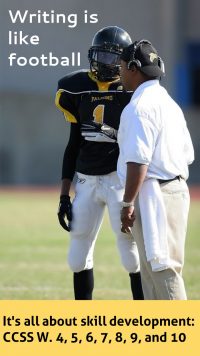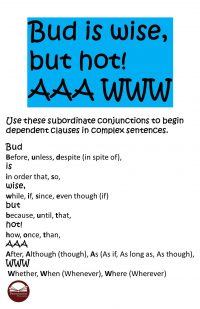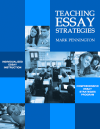How to Teach Essay Strategies
Writing is like football.
Most ELA teachers focus on teaching the W. 1, 2, and 3 standards: the argumentative essay, the informational/explanatory essay, and the narrative. Irrespective of using the writing process, we are content and product-driven.
Of course, football is all about the final product (the big game), as well; however, ask football coaches what they spend their practice time doing. They’ll mention their BIG 3: conditioning, tackle practice, and the omnipresent videotape. Less so the content and product-driven X’s and the O’s on the chalkboard. Perhaps we writing teachers should take a page from our coaches’ playbooks and be a bit more skill-centered. I’m talking about teaching the essay strategies that will prepare students for the big game. In other words, the CCSS W. 4, 5, 6, 7, 8, 9, and 10 standards.
Writing and football are all about skill development.
My first year of teaching was at a small K-8 school in Sutter Creek, California. I began teaching my first seventh-grade ELA class with a scintillating lecture, replete with masterful examples (including my own), on how to teach the five-paragraph essay. The structure, the components, and the unified balance of thought. “Go and do likewise,” I advised.
Of course, you probably already know the results. Most of my students did master the structure and had some sense of what the components were and where they belonged. But that unified balance of thought? I couldn’t understand why they just couldn’t fill in the rest of the blanks. Fortunately, after a few classes with U.C. Davis Area 3 writing mentors (Thank you!), I began to see the value of teaching the part-to-the-whole: the essay strategies, or skills, necessary to make sense of the content and structure.
After a number of years learning how to teach the essay, following are my BIG 3: 1. Eliminate the crutches 2. Teach and help students practice complex sentences. 3. Teach and help students practice grammatical sentence openers.
1. Teach and help students eliminate the crutches.
Sometimes removing a writer’s comfort zone is the only strategy that will force the writer to take the necessary risks to learn new tricks of the trade and improve his or her writing craft.
“To-be” Verbs: Restrict students’ usage of is, am, are, was, were, be, being, and been. Nothing forces students to search for concrete nouns and expressive verbs more than this strategy. Nothing makes students alter sentence structure more than this strategy. Nothing teaches students to write in complete sentences more than this strategy. After initial banishment, allow a few of these verbs to trickle into student writing, say one per paragraph. Sometimes the best verb is a “to-be” verb. After all, “To be or not to be. That is the question.” For more, see How to Eliminate To-Be Verbs in Writing.
1st and 2nd Person Pronouns: Essays designed to inform or convince are not written as a direct conversation between the writer and the reader. Instead of using the first person point of view I, me, my, mine, myself, we, us, our, ours, or ourselves pronouns or the second person point of view you, your, yours or yourself(ves) pronouns, essays are written in the third person point of view such as in the writing model below. It’s fine to use the third person he, she, it, his, her, its, they, them, their, theirs or themselves pronouns to avoid repeating the same nouns over and over again. Nothing forces students to focus their writing on the subject more than this strategy. Nothing teaches students to rely on objective evidence more than this strategy.
2. Teach and help students practice complex sentences.
Some prerequisite direct instruction is required here. Students need to know what an independent clause is. Students need to know what a phrase is. Students need to know what a dependent clause is. Teaching and memorizing the subordinate conjunctions are essentials. See How to Teach Conjunctions for a great memory trick. Students must be able to identify subordinating clauses and create them. Students need to be able to identify complex sentences and use them. Sentence models and analysis works well. I recommend using Sentence Revision, which uses sentence models and requires students to practice sentence combining and sentence manipulation at the sentence level. Using individual student whiteboards for practice and whole class formative assessment works well. You are going to have to differentiate instruction to ensure mastery learning of complex sentences.
3. Teach and help students practice grammatical sentence openers.
Students have been trained to write in the subject-verb-complement pattern. Fine. Now we need to revise that writing mindset. We need to teach students that writing style and sentence variety matter. I suggest that you limit your students to composing no more than 50% of their writing in the subject-verb-complement pattern. Teach students to begin their sentences with different grammatical sentence openers. See How to Improve Your Writing Style with Grammatical Sentence Openers for a fine list with examples. Nothing forces students to write with greater sentence variety than this strategy. Nothing integrates grammar instruction into writing better than this strategy.
Look for my next article on the Pennington Publishing Blog on helping students learn how to scrimmage. Focusing on the essay writing strategies at the paragraph level, including structure, style, unity, and evidence will further help students prepare for the “big game.”
Check out this complete writing process essay to see a sample of the resources provided in the TEACHING ESSAYS BUNDLE. The download includes writing prompt, paired reading resource, brainstorm activity, prewriting graphic organizer, rough draft directions, response-editing activity, and analytical rubric.
Get the Writing Process Essay FREE Resource:
![]()
The TEACHING ESSAYS BUNDLE is a comprehensive curriculum designed to help teachers teach the essay components of the Common Core Writing Standards. This step-by-step program provides all of the resources for upper elementary, middle school, and high school teachers to teach both the writing process essays and the accompanying writing strategies.
The TEACHING ESSAYS BUNDLE program includes the following resources:
Eight Writing Process Essays
The program includes the writing prompts, resource texts, graphic organizers, response, revision, and editing resources to teach eight Writing Process Essays. The first four essays are in the informative/explanatory genre (Common Core Writing Standard 2.0). The last four essays are in the argumentative/persuasive writing genre (Common Core Writing Standard 1.0). Accompanying resource texts include both literary and informational forms, as prescribed by the Common Core Reading Standards.
Diagnostic Assessment and Differentiated Instruction
This essay curriculum is built upon comprehensive assessment. Each of the eight Writing Process Essays begins with an on-demand diagnostic assessment. Teachers grade this writing task according to relative strengths and weaknesses on an analytical rubric.
Teachers differentiate writing instruction according to this diagnostic data with mini-lessons and targeted worksheets. Remedial resources include lessons in subject-predicate, sentence structure, sentence fragments and run-ons, essay structure, paragraph organization, types of evidence, transitions, essay genre, writing direction words, proofreading, introduction strategies, and conclusion strategies. Advanced resources include lessons in fallacious reasoning, logic, coherence, unity, sentence variety, parallelism, grammatical sentence openers, and writing style.






